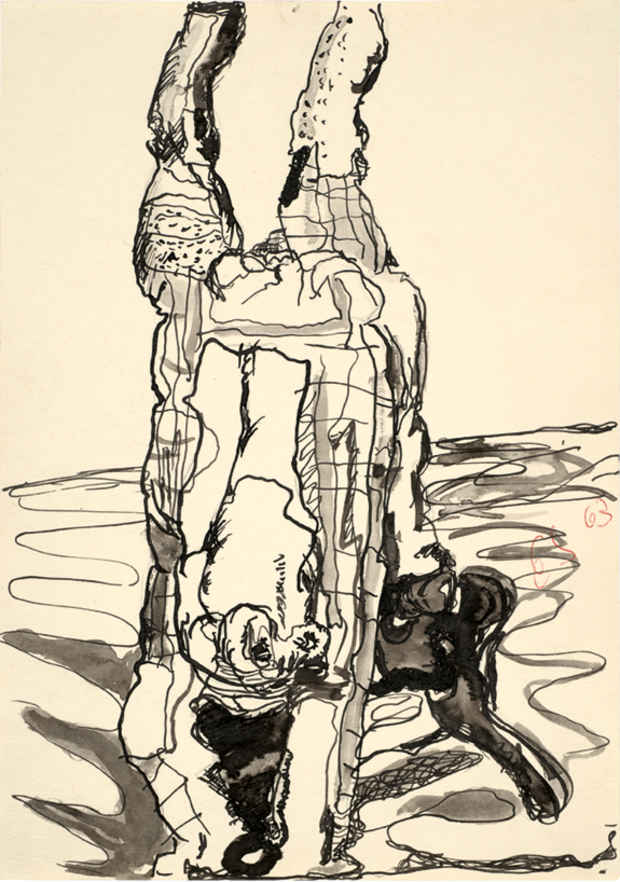"Eugen Schönebeck: 1957-1967” Exhibition
David Nolan Gallery

This event has ended.
David Nolan Gallery presents "Eugen Schönebeck: 1957-1967.” It has been more than forty-five years since Eugen Schönebeck, now aged 76, has made a work of art. He was one of the first German artists to take up the traumatic experiences of the Second World War as a theme, pioneering a unique manner of integrating historical content into his work. This is the artist’s first solo exhibition outside of his native country, an astonishing fact given the enormous impact of his brief career on the unfolding of postwar German art history. David Nolan Gallery has assembled over 35 works on paper and several paintings with the support of the artist, many of which have never been seen outside of Germany.
Schönebeck, who was born on the outskirts of Dresden, received a scholarship in 1954 to train as a decorative wall painter at the Fachschule für angewandte Kunst in Berlin’s East sector. Convinced that he couldn’t develop his artistry further in East Germany, he successfully applied for admission to the Hochschule für Bildende Künste in West Berlin, where he began to take classes in October 1955. He made his first trip to Paris in 1956, where he came to admire Art Informel, particularly the works of Hans Hartung, Jean Fautrier, and Henri Michaux. From this encounter his first mature drawings emerged in a Tachist style. The works that followed during the next four years retained figurative elements absent from the abstract paintings that he was also making at the time. It was not until late in 1961 that Schönebeck decided in favor of the more figurative mode of working. At times strangely humorous, the drawings that subsequently flowed from his hand abounded with an affinity for the grotesque. Schönebeck later stated his primary aim had been “to try…to let a certain tenor rise to the surface…a consciousness of crisis, pervasive sadness, gruesomeness, and even perverseness – that I found missing in the work of my colleagues.” In 1961, Schönebeck and his fellow student Georg Baselitz pilloried the bourgeois, jaded art world in their publication of the iconic First Pandemonic Manifesto. The manifesto doubled as the exhibition flyer for their self-staged debut exhibition as painters.
In the mid-1960s Schönebeck’s growing awareness of Soviet intellectualism in the former German Democratic Republic inspired him to create timeless portraits of various “Heroes of the East.” In these pictures, Schönebeck not only scrutinized the character and behavior of revolutionaries such as Lenin, Trotzky, and Mao, but also the significance of the artist’s willingness to take risks. These likenesses and the few large-scale drawings that followed attest to Schönebeck’s struggle to find a middle way between art made for the capitalist market and work harnessed to political ends. Disinclined to turn his back on either of these aesthetic traditions and unwilling to compromise the moralistic edge of his art, Schönebeck decided in 1967 to stop painting and withdrew from the art world.
Beginning with his student-era tusche and pencil drawings, this survey follows Schönebeck's move away from the established schools of the time. The earliest works shown, “Landscapes” from 1957 and 1958, pay homage to his contemporaries in Germany, while a selection of more unbridled drawings from 1960 recall Jackson Pollock and Abstract Expressionism. The core of the exhibition is a remarkable group of exaggerated figurative works created during the prolific period between 1962-1963. His subjects often appear mutilated—some in self-inflicted states of hanging, others shocked at the sight of a blown off limb. The survey concludes with Majakowski, a prime example of the monumental portraits he rendered in a startlingly realistic style in 1966.
Since the early 1980s curators, aware of the significance of his work, have included Schönebeck in almost every important survey exhibition of postwar German art presented internationally, including those at The Royal Academy of Art (1985), the Museum of Modern Art, New York (1987), the Centre Pompidou (1996), and the LA County Museum of Art (2009). This growing interest culminated in a retrospective of Schönebeck’s work at the Schirn Kunsthalle in Frankfurt this past year. Schonebeck’s art was well ahead of its time, and its meaning continues to endure, especially for a younger generation of artists.
[Image: Eugen Schönebeck "Sonnenbad (Sunbath)" (1963) tusche on paper, 11 3/4 x 8 1/4 in.]
Media
Schedule
from September 13, 2012 to November 03, 2012
Opening Reception on 2012-09-13 from 18:00 to 20:00